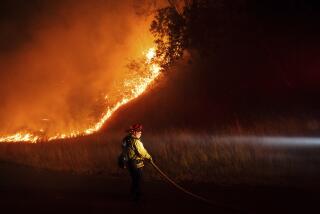Battling a wildfire: ‘Nothing sexy about it. It’s hard labor’
As I followed the news about the raging wildfire that claimed the lives of 19 firefighters in Arizona, I couldn’t help but recall the days I spent battling brush fires in California.
It’s something that happens every fire season as I report on wildfires or follow the news of blazes burning brush and destroying homes.
I spent nearly six years as a firefighter before a knee injury pushed me on a path that ultimately led to journalism.
I landed my first firefighting job a year out of high school with the Los Angeles County Fire Department. I worked on a camp crew and was stationed at Camp 2 in the La Cañada Flintridge area.
Our job was the same as the members of the hotshot crew that died Sunday: We cut firebreaks. It was dangerous, backbreaking work that we performed in extremely difficult conditions.
When I was at Camp 2, it had a helicopter that we used to respond to brush fires in places such as the Angeles National Forest, the Verdugo Hills and the brushy mountainsides of the Antelope Valley.
There were seven of us who would be dropped into fires, often with no source of water readily available. That meant cutting “hotline,” or carving a break right along the fire’s edge.
There’s nothing sexy about it. It’s hard labor. Pure and simple.
The first member of the crew had a chainsaw and cut the thickest pieces of brush. The second person was known as the “bucker,” and carried a shovel in one hand and with the other hand tossed the brush that was cut by the chainsaw.
If the brush was burning, you threw it into the fire. If it wasn’t, you tossed it to the unburned area. The bucker also carried a backpack with fuel, oil, extra chains and tools to put the new chains on the saw because they often broke.
The two people behind the bucker carried Pulaskis, which are fire axes used to cut brush not cleared by the chain saw. The next two members of the crew carried McLeods, or scraping tools that combine a hoe and heavy-duty rake to scrape the fire break. The seventh person was a captain, who monitored the fire line and carried a hand-held radio to communicate with other crews and help call in air strikes by helicopters or tanker planes.
It’s hard to convey the chaos of cutting hot line. Often you’re doing so as you climb up a rugged mountainside. The radiant heat from the fire can cause your arms to feel like they are burning. And the smoke can cause your eyes to burn and water, even if you are wearing goggles. On top of that, you have to be ready to drop to the ground and cover your tool with your body when a helicopter drops water or a plane drops fire retardant.
Both substances are heavy and can knock to you to the ground if you are standing. I once saw a firefighter get hit by a partial water drop in Via Verde. He was knocked down a hillside and suffered a concussion. I broke a toe when I missed a piece of brush with a Pulaski and the blade sliced through my boot. I once also ended up with a rash over my neck and chest after we cut a firebreak through poison oak.
It was a tough job, to be sure. But it was a great experience.
ALSO:Stanford alum makes record donation of $151 million
Triple-digit heat scorches Southern California inland areas
U.S. orders $12.5-million payment to victims of racial harassment
Twitter: @LAJourno[email protected]
More to Read
Sign up for Essential California
The most important California stories and recommendations in your inbox every morning.
You may occasionally receive promotional content from the Los Angeles Times.











